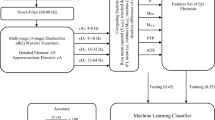Summary
-
1.
Stimuli in any modality evoke responses over wide regions of frontal non-specific human cortex.
-
2.
When identical stimuli are monotonously repeated these responses diminish irregularly and finally disappear.
-
3.
When stimuli are presented frequently in association, the responses to the first or conditional stimuli are amplified while those to the second or indicative stimuli are attenuated.
-
4.
When a subject is instructed to perform a relevant operant action to the second “imperative” stimulus the primary response to the conditional stimulus is followed by a prolonged negative wave which submerges the negative component of the imperative response.
-
5.
The negative wave linking the conditional and imperative responses is described as an Expectancy Wave (E-wave) because it reflects very accurately the attitude of the subject to the stimulus association and his intention to act on it.
-
6.
Comparison of intra-cranial and scalp records suggests that the E-wave arises from depolarisation of a small proportion of the apical dendrites in the frontal and premotor cortex.
-
7.
Development of the E-wave is accompanied by economical abbreviation of the motor reaction time to the imperative stimuli by synchronisation and restriction of the efferent motor volleys.
-
8.
When the imperative stimuli are withdrawn (extinction) without warning the E-wave subsides slowly over about 50 trials in normal adults. However, when a previous verbal warning is given the E-wave disappears at once.
-
9.
When the significance of the association between conditional and imperative stimuli is diluted by presenting a proportion of unreinforced conditional stimuli (equivocation) the E-wave is diminished accordingly and in normal adults vanishes when the probability of association falls to about 0.5.
-
10.
Stimuli involving no energy transfer to the subject but with a high information content evoke E-waves as long as the subject considers the signals interesting and important, whether they are isolated, imperative or conditional.
-
11.
The E-wave seems to indicate the subjective significance assigned by a particular person to the signal association or “Gestalt” used for the experiment. The significance thus determined includes the need for recognition or decision, and involves social as well as physiological influences.
Zusammenfassung
-
1.
Sinnesreize aller Modalitäten erzeugen über weiten Bereichen der frontalen Hirnrinde elektrische Antworten, die im integrierten EEG oder durch direkte Hirnableitung registriert werden.
-
2.
Wenn gleiche Reizmodalitäten wiederholt werden, vermindern sich die Reizantworten in unregelmäßiger Abfolge, um schließlich zu verschwinden.
-
3.
Wenn zwei Reize häufig nacheinander gegeben werden, so werden die elektrischen Antworten nach dem ersten konditionierenden Reiz vergrößert, nach dem zweiten indikativen Reiz vermindert.
-
4.
Wenn die Versuchsperson die Aufgabe erhält, auf den zweiten „imperativen“ Reiz zu reagieren, so folgt der ersten Reizantwort auf den bedingenden Reiz eine verlängerte negative Welle, die mit der negativen Komponente der imperativen Antwort verschmilzt.
-
5.
Die negative Welle, die bedingende und imperative Antworten verbindet, wird als Erwartungswelle (Expectancy Wave, E-wave) bezeichnet, weil sie genau einer Erwartungshaltung der Versuchsperson auf die Reizkombination und seiner Aktionsbereitschaft entspricht.
-
6.
Vergleiche von intrakraniellen und Kopfhaut-EEG-Registrierungen lassen vermuten, daß die E-Welle durch Depolarisation eines kleinen Teiles apikaler Dendriten der frontalen und prämotorischen Hirnrinde entsteht.
-
7.
Die Entwicklung der E-Welle ist verbunden mit einer zweckmäßigen Verkürzung der motorischen Reaktionszeit auf den imperativen Reiz durch Synchronisierung und Begrenzung der efferenten motorischen Entladungen.
-
8.
Weglassen der imperativen Reize (Extinktion) ohne Warnung läßt die E-Welle allmählich nach etwa 50 Reizen beim gesunden Erwachsenen erlöschen. Wenn das Ausbleiben des imperativen Reizes sprachlich angekündigt wird, verschwindet die E-Welle sofort.
-
9.
Wenn die Bedeutung der Verbindung von bedingendem und imperativem Reiz durch isolierte Bedingungsreize vermindert wird (Äquivokation), so vermindert sich die E-Welle dementsprechend und verschwindet beim normalen Gesunden, wenn die Wahrscheinlichkeit einer Reizverbindung unter 0,5 fällt.
-
10.
Reize mit hohem Informationsgehalt ohne Energieübertragung lösen E-Wellen so lange aus, wie die Versuchsperson die Signale als interessant und wichtig auffaßt, gleichgültig, ob sie isoliert, imperativ oder bedingend gegeben werden.
-
11.
Die E-Welle ist offenbar Zeichen der subjektiven Bedeutung, die eine Person der Signalverbindung oder einer Gestalt beim Experiment zuschreibt. Die Bedeutung enthält damit die Notwendigkeit vorangehender Erkennung und Entscheidung und korreliert mit sozialen und physiologischen Einflüssen.
Similar content being viewed by others
References
Black, S., and W. Grey-Walter: Human brain responses to variations in the subjective and objective probability of association between stimuli. Brit. med. J. (in press) (1964).
Caspers, H.: Changes of cortical d. c. potentials in the sleep wakefulness cycle. In: The Nature of Sleep. London: Churchill 1961.
Cooper, R., A. L. Winter, H. J. Crow, and W. Grey-Walter: Comparison of subcortical, cortical and scalp activity using chronically indwelling electrodes in man. Electroenceph. clin. Neurophysiol (in press) (1964).
Kornhuber, H. H., and L. Deecke: Hirnpotentialänderungen beim Menschen vor und nach Willkürbewegungen, dargestellt mit Magnetbandspeicherung und Rückwärtsanalyse. Pflügers Arch. ges. Physiol. 281, 52 (1964).
Rowland, V., and M. Goldstone: Appetitvely conditioned and drive-related bioelectric baseline shift in cat cortex. Electroenceph. clin. Neurophysiol. 15, 474 (1963).
Rusinov, V. S.: General and localized alterations in the electroencephalogram during the formation of conditioned reflexes in man. Electroenceph. clin. Neurophysiol. Supp. No. 13 (Moscow Coll.), 309 (1960).
Shvets, T. B.: Slow electrical processes in the cerebral cortex of the rabbit. Conf. Electrophysiology of Higher Nervous Activity (Russian abstracts) Moscow, 138 (1958).
Walter, W. Grey: The convergence and interaction of visual, auditory, and tactile responses in human nonspecific cortex. Ann. N. Y. Acad. Sci. 112, 320 (1964).
Walter, W. Grey, R. Cooper, V. J. Aldridge, W. C. Mccallum, and A. L. Winter: Contingent negative variation: An electric sign of sensorimotor association and expectancy. Nature (Lond.) 203, 380 (1964).
Walter, W. Grey, and H. J. Crow: Depth recording from the human brain. Electroenceph. clin. Neurophysiol. 16, 68 (1964).
Author information
Authors and Affiliations
Rights and permissions
About this article
Cite this article
Walter, W.G. Slow potential waves in the human brain associated with expectancy, attention and decision. Archiv für Psychiatrie und Zeitechrift f. d. ges. Neurologie 206, 309–322 (1964). https://doi.org/10.1007/BF00341700
Received:
Issue Date:
DOI: https://doi.org/10.1007/BF00341700




